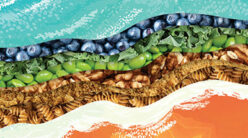My high school teammate Tommy called to tell me that the father of one of our friends had died at home. I was devastated by this news. As a typical teenager, I believed that we and all those around us were immune to the misfortunes of sickness and disease. Our friend’s father was 35 years old and had no history of cardiovascular disease. We later learned that the day before he died he had developed aching in his left arm and slight nausea, but believed this to be only the fatigue of hard work. He had mistaken cardinal symptoms of myocardial ischemia (not getting enough oxygen to the heart muscle) for minor aches and pains.
Four hundred thousand of an estimated 1 million heart attack victims in this country die each year. Thus it is important to recognize the symptoms of ischemia early. These symptoms may be an uncomfortable pressure, fullness, squeezing, or dull pain in the center of the chest, upper abdomen, neck, jaw, shoulders, upper back, or arms. Additionally there may be sweating, nausea, or shortness of breath. The character of the pain may be a pressure, a tightness, burning, or a heavy weight that may be either intense or mild. There may be an increased heart rate or an irregular beat and pallor of the skin. The pain may spread or originate in either arm, but is usually in the left arm. Light-headedness may be present, as well as a feeling of impending doom.
These symptoms are a result of a reduction or total blockage of blood flow through the arteries of the heart and can lead to irreversible injury of the heart muscle if not evaluated and treated promptly. Unfortunately, it is not uncommon for one to ignore the symptoms listed, since they may not persist or may not be severe. It is important to seek medical help if you have any of the above symptoms even if they go away, since 90 to 95 percent of heart attack patients who are admitted to a hospital survive.
Many of the heart attack deaths are caused by electrical disturbances that produce ventricular fibrillation–a rhythm disturbance that produces an ineffective beating of the heart and results in death within minutes if not reversed by defibrillation. Portable defibrillators are being placed in high-occupancy areas such as athletic stadiums or civic centers. These can be used by nearly anyone who can turn on the machine and follow the self-prompting directions. Time is particularly critical in this instance, but is also extremely important in treating the blockage in the artery in order to prevent damage to the heart muscle.
Myocardial ischemia is caused by the formation of a blood clot on a cholesterol plaque present on the wall of a heart (or coronary) artery. If there is inadequate blood to supply the heart muscle with oxygen and nutrients, then the heart muscle dies (myocardial infarction). Therefore, the most important factor in preventing damage to the heart muscle is seeking out medical attention promptly. The goal of treatment is to restore the flow of blood through the blocked artery by either coronary angioplasty or the administration of drugs to dissolve the clot. The best results are obtained if blood flow can be reestablished within four to six hours of the onset of symptoms.
Coronary angioplasty is done in a cardiac catheterization lab and involves placing a hollow tube slightly larger than spaghetti into the femoral artery (usually in the right groin if the physician is right-handed) and threading it “upstream” to the heart. The coronary arteries that feed the heart muscle take off from the aorta, the large vessel leading from the heart to the other parts of the body.
The physician injects a clear contrast material at the origin of these vessels, and the fluoroscopic continuous X-ray device shows this liquid as white. This contrast outlines the coronary arteries to show the location of the blockage. A guide wire is left at the point of the blockage and another catheter is threaded over it. A small balloon at the end of this catheter is inflated and opens the blocked area. Then a small hollow tube, or stent, is placed in the opened area to prevent recurrence of the block and lowers the risk of a repeat heart attack. For this to be effective, the procedure must be done within six hours of the onset of symptoms, preferably within the first hour.
An alternative to coronary angioplasty is the administration of potent blood thinners to dissolve the clot causing the blockage. Again, initiation of the therapy must be early. Six hours after the onset of symptoms most of the damage to the heart muscle has occurred. These “clot-busters” or thrombolytic agents are given intravenously. If done early, they can successfully open 80 percent of acutely blocked coronary arteries.
During the hospitalization, other drugs are given: heparin, an anticoagulant, keeps the clot from reforming; antiplatelet drugs such as aspirin keep the platelets (the “sticky part” of the blood that aids in clot formation) from clumping together to form a clot; nitroglycerin, a vasodilator, opens the coronary artery by relaxing the muscular wall of the vessel; ACE (angiotensin converting enzyme) inhibitors are another type of vasodilator that can reduce the workload of the heart and help the damaged muscle to recover. For the long term, beta-blocking agents such as propanolol, metoprolol, or atenelol are given to improve survival and decrease the risk of recurrent heart attack. Certain patients are not candidates for thrombolytic therapy because of a history of bleeding ulcer, recent stroke, trauma, or surgery.
Sudden death from a heart attack can often be thwarted by the prompt administration of cardiopulmonary resuscitation. If a patient has ventricular fibrillation as a result of a heart attack, brain damage or death may be prevented by mechanically pumping the injured heart by external chest compression. After the paramedics arrive, advanced CPR can be carried out with administration of drugs and defibrillation if needed.
Some patients will die despite immediate CPR and defibrillation, and others will die after admission to the hospital even when they have received timely care and prompt institution of angioplasty or thrombolytic therapy. It is truly distressing to lose a patient who has made it to the intensive-care unit, but it does happen despite the very best care rendered. But one can increase his or her chances for survival by seeking medical help at the very onset of symptoms that may be referable to ischemia of the heart muscle.
A final note: heart attacks frequently occur between the hours of 4:00 a.m. and 10:00 a.m. because of greater amounts of adrenaline released from the adrenal glands. If you feel pain, have shortness of breath, nausea, sweating, or any of the other symptoms listed above, do not wait until morning to go to an emergency room. Go immediately. Hopefully, it will be only indigestion. But if not, you may save the only heart you’ll ever have.






